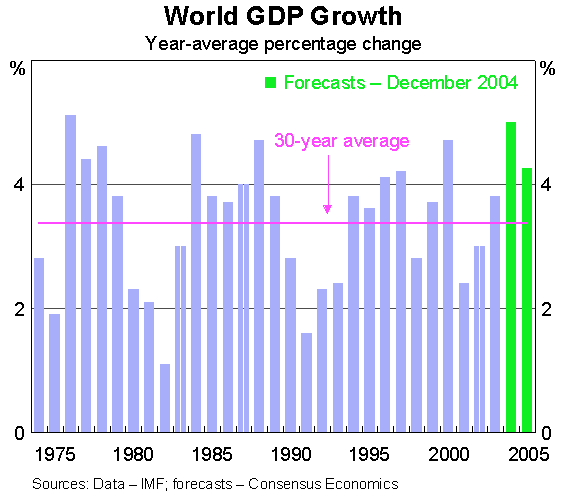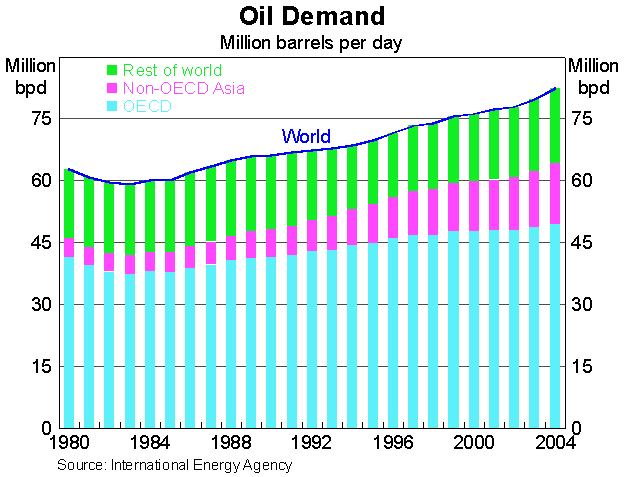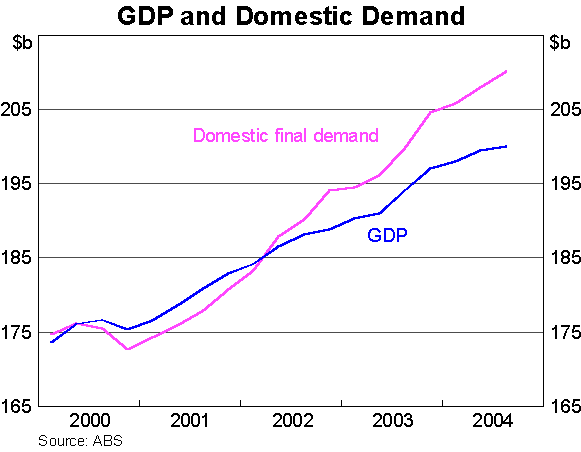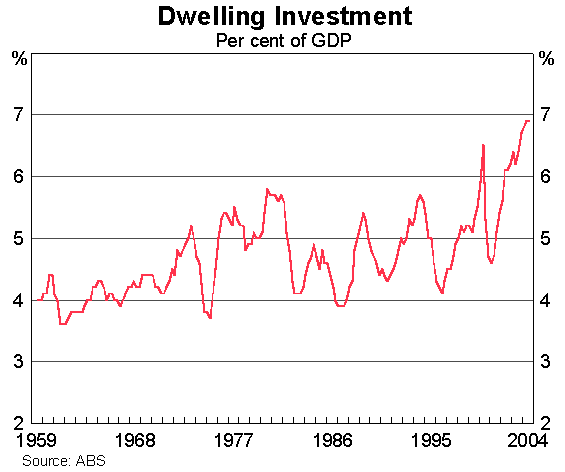Speech Economic and Financial Conditions December 2004

Glenn Stevens
Deputy Governor
Address to the Australian Business Economists
and the Economic Society of Australia (NSW Branch)
Annual Forecasting Conference Dinner
Sydney –
PDF version 166KB
2004 turned out to be a year of considerably stronger output in the global economy. According to the international panel of private forecasters recently polled by Consensus Economics Inc, global GDP[1] will have risen by 5 per cent in 2004. This does not include the recent round of data revisions in Japan, and so may be adjusted down a little. Even so, it is hard to see how the outcome will not be at least a full percentage point above the long-run average and as strong as any year in the past thirty.

As always, there were short-term departures from the established trend. The US ‘soft patch’ in mid year followed a brief period when price statistics in the US had people worried about inflation. The number one topic of discussion the previous year, of course, had been deflation. There were also periodic concerns that the attempts to engineer a slowdown in China might over-achieve, resulting in a slump of global significance. The various short-term concerns were overdone, as is so often the case, but were to be expected given that an innumerable army of analysts, commentators and financial market players extensively debate every twist and turn of the economic data, many of which turn out to be statistical noise. A more genuine reason for some discomfort is perhaps that, despite vigorous global growth in total, there is a feeling that it is a little lop-sided, with some areas participating less than fully. The euro area, for example, has struggled to ‘gain traction’.
In 2005, some slowing is envisaged but forecasters apparently expect growth still to be better than average. It might be revised down a bit in the near term reflecting some softer recent data. But even a noticeable downgrade would leave growth at about average, which would be quite a reasonable outcome. In the course of expansions lasting a number of years, it is quite common for there to be the odd slower year; they can't all be above average.
One factor affecting people's expectations will presumably be energy prices. Measured against the SDR, so as to avoid valuation effects of the decline in the US dollar, the average oil price in the second half of 2004 was about 50 per cent higher than the average over the period 2001–2003.
Assessing the implications of this change requires us first to ask why it occurred. The oil shocks of the mid and late 1970s resulted from OPEC actions to drive up the price by restricting supply. In such a scenario, costs of production for industrial users of energy are raised, which means some combination of higher prices and lower profits ensues. Possibly some of the capital stock is rendered uneconomic. For households, the rise in oil prices reduces purchasing power, so imparting a contractionary impact on other areas of demand.[2]
The situation when the disturbance emanates on the demand side is different. The initiating shock here is expansionary in nature: somewhere in the world, there is unexpected strength in energy-intensive production of goods and services. Prices rise, but so does output. Admittedly, output would have risen even further had the supply of oil been perfectly elastic, but a demand-driven rise in oil prices is a sign of global growth strength, not weakness.
That is the bulk of the story in the past few years. With global GDP having grown by about 12 per cent over the past three years, oil demand is estimated to have increased by about 6½ per cent over the same period. Granted, there have been periods of pressure on prices driven by uncertainty over current or future supply, but the main story is one of demand.
There is, of course, an important compositional element too. Much of the additional growth in demand is coming from the Asian region. This means that traditional big users of oil in the developed countries are competing for resources in a way they had not been accustomed to doing in the past. A rise in the oil price could well seem to them quite like the supply shock scenario – higher prices and lower output. Hence, if oil prices were to remain quite high, economic prospects for some of the western industrial countries, particularly those whose economies were not especially robust to begin with, could be more noticeably affected than would be the case in, say, China or India.

A really serious adverse shock from this source looks less likely now, however, than it did a month or two ago, with oil prices having declined quite sharply from their peak. Financial markets have certainly responded in a fairly relaxed way to these developments. Bond yields remain fairly low by historical standards, particularly given the back-drop of a tightening cycle by the Federal Reserve. This is a rather different response to some other episodes where oil prices have risen substantially, as shown in the table below, which suggests that a persistent rise in inflation is regarded as unlikely. This may reflect an expectation that the adverse effects on growth for the industrial countries will inhibit any lasting inflation impact, but is also consistent with the idea that neither growth nor inflation may be affected by very much or for very long.
| Beginning of Oil Price Rise | Change in Bond Yield (bps) |
|---|---|
| September 1973 | +104 |
| December 1978 | +118 |
| June 1990 | −19 |
| February 1999 | +113 |
| October 2003 | −28 |
|
Source: US Federal Reserve, Global Financial Data |
|
The latter view probably fits more easily with the fact that markets are demanding relatively little compensation for credit risk. A significant weakening of growth in the industrial countries would surely have some adverse implications for emerging market countries, and lesser quality corporates. If that were expected, we would presumably see it reflected in risk spreads – but we do not see that. At present, then, markets apparently do not anticipate much in the way of adverse impact from the energy price changes. Either that, or there is a tension between various markets, the resolution of which will be fascinating to watch.
But the main point is still that the current level of oil prices is mainly a sign of global demand strength – it is just that some of the strength is in different places from historical patterns. For Australia, a global growth situation that is strong enough to be exerting upward pressure on energy (and other resource) prices, and where growth is weighted towards Asia, seems for the moment to be quite a favourable one.
According to the national accounts, Australia recorded moderate growth in 2004. It looks like GDP growth over the four quarters to December will be less than 3 per cent unless there is a big surprise for the December quarter or upward revisions to previous quarters. Let me leave aside the apparent contrast with the picture painted by the various business surveys, which is considerably stronger, and for the moment take the figures as given.
That leaves growth running more slowly than was anticipated earlier in the year. But if output growth fell slightly short of expectations, it was not due to apparent lack of demand. Growth in domestic final demand has run at something like 5 per cent over the past year, and an average rate of nearly 6 per cent per year over the past three years. And growth in global demand for things Australia produces has, over the past year or two, been generally as strong as at any time in the past few decades.

If demand growth is so strong, why hasn't the economy grown faster? Have we hit capacity limits?
Indicators of capacity utilisation available in business surveys are certainly at or close to the highest levels seen in the past 15 years. This is a feature across surveys, and has been for some time. In the labour market, the rate of unemployment is at its lowest for more than 25 years. Other measures of under-utilisation of labour are not at two-decade lows, but have nonetheless declined a good deal. A significant proportion of firms refer to difficulties in finding suitable staff. Areas of skill shortage have emerged. Observable upward pressure on wage and salary rates is minor at this stage, though there are reports of non-wage employment costs rising in some sectors.
The clearest evidence of hard capacity constraints is probably on the export side. In some parts of the resource sector there was a significant volume of investment in the second half of the 1990s, but a subsequent period of weak commodity prices saw investment decline to very low levels. Hence, the increase in demand in the past two years apparently left some producers without the capacity to take full advantage of the conditions by shipping higher output, though of course they have enjoyed higher prices. The rise in prices presumably reflects pressure on capacity globally, which suggests that producers everywhere were surprised. There have also been reports of capacity constraints in some of the key areas of transport infrastructure, such as ports and rail. A decline in exports of some fuels was due to a rundown in reserves, a capacity constraint of another sort.
At the margin, the weakness of manufactured exports might reflect the strength of domestic demand, which for some producers may have presented an opportunity for sales in an easier market than some foreign alternatives. It might reflect the rise in the exchange rate (i.e. demand rather than supply), though the export weakness dates from a time when the exchange rate was much lower.
So where does this leave us? There is no hard and fast answer, but there are reasonable grounds for thinking that the Australian economy is now operating closer to full capacity than it has for some time. We don't want to overstate this: it could not be claimed that physical limits have been reached across the board (though apparently they have been in a few areas). The best forecast for inflation, moreover, remains one of only a gradual increase over the coming two years, and no recent price or wage data have cast any doubt on that view. But it does seem to be getting a bit harder to coax above-average growth from the economy.
In the thirteenth and fourteenth years of expansion, this is not surprising. Most of the easy gains in lifting output by reducing cyclical slack are by now behind us. It just means that very strong demand growth is now less likely than before to foster rapid output growth and more likely, at some stage, to risk pressure on prices, even though that does not seem imminent at the moment. It was therefore appropriate to have the somewhat less accommodative monetary stance of the past year and to signal in recent Statements the likelihood – assuming the economy evolved as expected – of higher interest rates at some stage. A continuation of a robust expansion will, it seems, be increasingly dependent on enhancing the supply side: growing the capital stock, more effectively matching the supply of and demand for both skilled and unskilled labour, and innovation to lift the productivity of all the factors of production.
I have talked about exports, but not as yet addressed the issue of Australia's current account deficit. But since it has been in the news recently, is there anything useful to be said? The risk in this is that people may misinterpret my remarks as indicating that the current account deficit is, per se, something to be addressed by monetary policy. So I shall state clearly that it is not. Actually, whether the current account position should be an objective of any policy is not obvious – that would need to be argued. But whatever one's view on that question, let me be clear that the current account is not, and should not be, an objective for monetary policy. We have had that debate in Australia. It was settled more than a decade ago, and I do not wish to re-open it.
With those preliminaries, let us see what can be said about recent trends. The trade arithmetic is well-known. It may therefore be of more interest to examine the financial counterparts – that is, to look at the changes in saving and investment behaviour. The table examines, from this perspective, the six episodes of current account widening over the past 25 years.
| ΔSaving | ΔInvestment | Of which dwellings |
ΔNet | ΔCAD | |
|---|---|---|---|---|---|
| Dec-79 to Dec-81 | −0.9 | 3.9 | 0.7 | −4.8 | −4.8 |
| Dec-83 to Jun-86 | −1.0 | 1.9 | 0.2 | −2.9 | −3.1 |
| Mar-88 to Mar-90 | 0.3 | 1.5 | 0.7 | −1.2 | −3.1 |
| Dec-93 to Mar-95 | −0.8 | 0.7 | 0.2 | −1.5 | −3.5 |
| Jun-97 to Mar-99 | −1.4 | 2.9 | 0.7 | −4.3 | −4.0 |
| Sep-01 to Sep-04 | −1.3 | 3.0 | 1.7 | −4.3 | −4.7 |
|
Source: ABS |
|||||
In the majority of episodes, the share of national income being saved declines. In every episode, investment increases. In each case, part of the rise in investment is dwelling investment. But what is striking is the prominence of dwelling investment in the latest episode. The size of the run-up is much larger than in the other five episodes. As of the middle of 2004, moreover, according to the national accounts, dwelling investment was almost 7 per cent of GDP[3], higher even than the feverish pre-GST peak, and a full percentage point of GDP higher than at the other peaks in the past 40 years.

This was not obviously related to population growth, which was not unusually high in the recent period. The number of new dwellings constructed was not unusual compared with previous booms. What is new is that the quality and size of dwellings, both new dwellings and those being renovated, are higher than in the past. That is to say, the community has much higher standards for accommodation than was formerly the case, and is investing additional resources accordingly.
Was this a good investment? For that part of the investment undertaken in expectation of commercial returns, some reservations must be recorded. Rental yields are now low compared with history, and hence capital gain is presumably required for an acceptable return to be earned. But with assets generously priced, and signs that capital values are in fact declining, there is a good chance many of these investors will find themselves disappointed.
For owner-occupiers, the question of whether it was a good investment has no clear answer. Unlike investment for business purposes, which is presumably undertaken in expectation of a cash return, the main return from a higher quality dwelling stock for owner-occupiers will be an enhanced flow of dwelling services, which is not received in cash. These households were confident that their future income would be sufficient to afford that higher consumption of dwelling services, paid for in the form of higher debt servicing. We can't know as yet whether or not that judgement was correct.
Is the rise in the current account deficit associated with this, in itself, a problem?
To assess that, it is helpful to ask two questions:
- what are the risks? and
- who is running them?
In cross-border capital flows, the main complication is that someone is bearing exchange rate risk. If a current account deficit turns out to be a problem, it is usually because domestic entities have borrowed foreign currency unhedged. At some point the exchange rate falls, leaving the financial position of borrowers under strain, as both the principal value and the debt servicing cost of the loan are higher in terms of the local currency in which the borrowers earn their income.
But in this case the borrowers' obligations are in Australian dollars, not foreign currency, and the same is true for the intermediaries who funded the loans (and hedged their risk). Foreign suppliers of capital are, in fact, bearing the exchange rate risk. So if there is a problem here, it is not that Australian households borrowed from foreigners, in particular, to fund investment in the dwelling stock, it is that they borrowed from anyone to do so. The risk they are running is not exchange rate risk, it is simply that their future income may not be as high as expected, leaving it harder than they anticipated to service their Australian dollar borrowings. This is another way of saying what we have said a number of times: that a position of higher leverage leaves households more vulnerable than they would otherwise have been to a negative shock to income. How serious a risk this ultimately is remains to be seen, but the same degree of concern would, in my view, be there regardless of the state of the current account.
In saying this, I am mindful that those who are bearing the foreign exchange risk might wish to change that exposure, or just slow the rate at which they accumulate it, for one reason or other, at some time or other. What would be the implications of such a change in view?
It is fairly extreme to assume that there would be a total ‘sudden stop’ of capital flow, as occurs periodically for some emerging market countries operating under fixed exchange rates that become unsustainable. In all Australia's experience under the floating exchange rate over the past two decades, that has never occurred. Even in the days of greatest concern about the external accounts in the 1980s, substantial capital inflow into Australia continued – the equivalent of between 3 and 6 per cent of our GDP per annum. What did occur, on occasion, was that the cost of foreign capital rose, mainly in the form of a decline in the foreign currency price of Australian assets – i.e. a fall in the exchange rate. Were concern about the current account position to emerge at some point in the future, a similar result might be expected.
Having said that, no one can know if such an adjustment will occur, let alone when. But if it did occur, the experience of the past decade suggests we would be able to cope. We have absorbed substantial exchange rate movements, without the economy being derailed. So it seems to me that rather than fretting about the current account deficit per se, it is more sensible to focus on the underlying imbalances in the economy. The current account outcomes may be pointing out those imbalances – indeed the high current account deficit of the past couple of years does point to the housing story – but it was the behaviour driving the imbalance, rather than the nationality of those supplying the funds, that was the issue.
Conclusion
At this time of year, it is often tempting to think that the year was full of the unexpected. But as these things go, 2004 was not especially exciting. Despite various risks, global economic growth went pretty well. It was not derailed by geopolitical uncertainty, SARS, financial crisis or by ‘global imbalances’. In fact, it offered an external environment for Australia that has seldom been bettered.
At home, the economy turned in a steady performance. Unemployment is lower than a year ago, confidence and profits are high, inflation contained. Even if growth seemed, on the official data, a little lower than expected, it was not for want of demand, suggesting that the focus on supply-side improvements – always very important – should come even more to the fore. The most significant imbalance – a credit-funded boom in purchase of housing – began to unwind in about the most benign fashion one would dare imagine. One can only hope that 2005 turns out to be similarly uneventful, at home and abroad.
No doubt there is something unexpected coming down the road. In time we shall see what it is. But for now, I wish you all a very merry Christmas, and a prosperous (and uneventful) new year.
Endnotes
As measured by the IMF's PPP-weighted approach. [1]
A key assumption of this analysis is that there is only limited short-term scope to substitute towards other sources of energy or to otherwise use oil more efficiently, which is reasonable for the short term though not the long term. It also assumes that the income gain accruing to oil exporters does not lead to demand expansion in those countries sufficient to offset the contractionary impact in the oil-importing countries. [2]
This figure excludes the transfer expenses associated with investment activities, which for dwellings grew to be about 1½ per cent of GDP by mid 2004 (but has since fallen due to the decline in real estate turnover). [3]